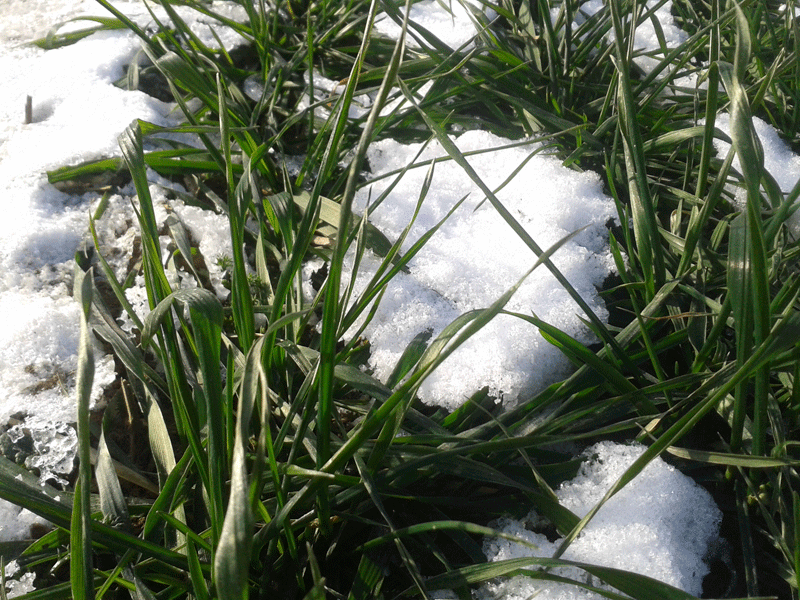The waiting game
WINTER WHEAT 2015
WINTER WHEAT PRODUCERS who dealt with the effects of last winter’s thaw-and- freeze challenges are finding a new set of problems to worry about for 2015’s crop. The late harvest of soybean and corn crops combined with poor field conditions delayed winter wheat planting across much of Ontario. Only about 615,000 acres of an anticipated one million acres even made it into the ground; and because of the late start, some fields had yet to emerge by the time the snow flew.

“Fall 2014 was even worse than fall 2013, and 2013 was bad,” says Peter Johnson, cereals specialist — field crops with the Ontario Ministry of Agriculture, Food and Rural Affairs (OMAFRA). “A significant amount of the crop was planted in the first week of November — growers were able to plant for an additional seven days thanks to changes in Agricorp’s winterkill coverage.”
AGRICORP DEADLINE EXTENSION IS PERMANENT
Agricorp extended the planting deadline for winter wheat by seven days in most areas of the province. Although the deadline extension was announced on a particularly wet year, the extension is a permanent one.
“The planting deadline extension for winter wheat just happened to work out on a year that a lot of growers were late in their planting,” says Jim Zavitz, senior industry specialist for winter wheat, Agricorp. “We wanted to reflect that there are better varieties and management options now, and that we could safely extend the planting date without anticipating more claims.”
With only one year of data, Zavitz is not prepared to draw any conclusions on what it means for Ontario’s wheat crop; but he notes that provincially, 20.9 per cent of winter wheat acres were planted between the old deadline and the new deadline. Eastern Ontario saw the biggest benefit, with close to 50 per cent of that region’s winter wheat planted at the new deadline, compared to about 11 per cent in central and southern Ontario.
EXPECT TO STRUGGLE WITH TREND LINE YIELDS
Historically, the earlier any crop is planted, the higher the yields. Johnson says yield potential ranges heavily — a September planting that might offer a potential of 150 bushels per acre, will yield closer to 110 bushels per acre when it is planted in November — if everything else goes right.
“Realistically, we almost never achieve our full yield potential anyway,” Johnson says. “This year’s crop by January 2015 is not as drastically different from the crop in January 2014 as some people might expect.”
Winter wheat continues to lie dormant and is blissfully unaware of the freezing rain that fell on bare fields in parts of Ontario in early January. Come March or April, growers may find their crop better off than last winter — provided they manage it appropriately.
NITROGEN, NITROGEN, NITROGEN
Producers with fields of late-planted wheat that did not reach the tiller stage or barely emerged in the fall will need to put more effort into encouraging tillering in the spring.
“As early as possible, on a cold night when the maple sap runs, growers need to get out of bed and apply 30 or 35 pounds of nitrogen,” says Johnson. “They should apply it on frost, not frozen soil, so if they get wet weather it won’t all wash away.”
However, just because the crop needs nitrogen, more is not better. Johnson says 30 pounds or 130 pounds will have the same impact on the crop at this stage. Although the beginning of March will be too early to look for winterkill in wheat that has barely emerged or hasn’t emerged at all, 30 pounds of nitrogen on the soil will not be wasted if the crop does not work out and the field eventually shifts to corn.
Johnson adds for growers who are planning to apply sulfur, he would strongly encourage them to put it on with the first application of nitrogen. “In the case of urea, you’ll be adding some ammonium sulfate, and the ammonium portion will be immediately available to the wheat,” he adds.
GIVE IT TIME
In spring 2014, 15 per cent of the crop was eventually replanted due to winterkill — but Johnson points out that the number might have been much higher if wet weather hadn’t kept tractors out of the fields.
“By April 20, much of the crop was late and struggling, but it got too wet to replant right away,” Johnson says. “Two or three weeks later, many growers reassessed their fields and saw the wheat had rebounded, and ended up producing between 75 and 85 bushels per acre — far better than expected.”
Johnson advises growers to delay the decision to replant as long as possible, to give wheat a chance to show itself. “Plant your other crops first,” he says. “Then come back and check on it.”
CALLING IN COVERAGE
Wheat producers who have to make the call on winterkill and possible reseeding should do so around the end of April or early May. Zavitz says producers have until May 1 to get their winter wheat crop insured for production only coverage. Producers who missed the fall deadline or planted wheat after the deadline can request Agricorp to come out and inspect the wheat.
“As long as there is a good stand of wheat there, we can insure it for production coverage before May 1,” Zavitz says. •
Contact Agricorp at 1-888-247-4999 or www.agricorp.com.






















